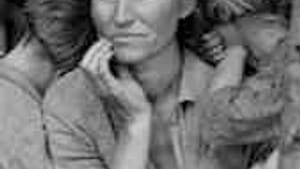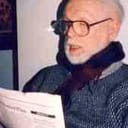Stay in the Loop
BSR publishes on a weekly schedule, with an email newsletter every Wednesday and Thursday morning. There’s no paywall, and subscribing is always free.
America's 1930s, in detail
Peter Conn's "The American 1930s'

Penn professor Peter Conn's The American 1930s: A Literary History, is a scholarly wonder about a painful period. In the lee of reading with great pleasure Morris Dickstein's cultural history of the '30s, Dancing in the Dark, I'm astonished to see how their diverse complementary perspectives make so comprehensible the complexities of that tortuous decade.
Dickstein's angle is more aesthetic, Conn's more sociological. Together my perspective became more and more three-dimensional. Dickstein is better at compare and contrast, Conn at making sure nothing important is ignored.
For example, Robert Penn Warren's Southern vision is clearly explained by Dickstein, but Conn shows how Warren's first book, John Brown: The Making of a Martyr, denigrated the heroic outsider. (That was long before Malcolm X changed Warren's Southern mind.) And Conn shows in Warren's Night Rider how Warren's Kentucky home folks fought the American Tobacco Company monopoly.
Beyond Gone With the Wind
Beyond the usual dominance of Gone with Wind, Conn points out how Marjorie Kinnan Rawlings's The Yearling revealed how poor Southern whites dealt with Reconstruction. Conn's book contains a list of Pulitzer Prize fiction and nonfiction winners as well as best sellers in that decade: his website shows how his classes use these aids to broaden and deepen student literary sophistication. He prefaces his book with a cultural and political timeline, an indispensable aid to an American like me who lives in Germany.
Conn deploys so many details: WPA writing, theatre, and painting; handbooks of American design and architecture; the Dictionary of American Biography. You get the impression that Conn wants every English teacher trained at Penn to know about every aid that will make them more professional.
While Dickstein alludes to the way left-wing black intellectuals resented wealthy whites "slumming" in Harlem, Conn actually quotes Richard Wright's putdowns. Wright described the Harlem Renaissance writers as "prim and decorous ambassadors who went a-begging to white America…. They entered the Court of American Public Opinion dressed in the kneepans of servility, curtsying to show that the Negro was not inferior, that he was human, and that he led a life comparable to that of other people. For the most part these artistic ambassadors were received as though they were French poodles who do clever tricks."
Wright lampooned Zora Neale Hurston as the character Sweetie May Carr, and needled poet Countee Cullen as Dewitt Clinton. Similarly, Conn analyzes the many left-wing manifestos that thrived in the decade.
Hitting the road
He seems to know everything cultural in that era, even the pioneering Karamu House in Cleveland, where Langston Hughes's Emperor of Haiti was first performed in 1936. That play concerned the failed 1791 revolt of Jean-Jacques Dessaline, motivated by the French Revolution. Conn also mentions William Levi Dawson, a music professor at Tuskegee (where he taught Ralph Ellison), who arranged dozens of African-American spirituals to form his Negro Folk Symphony, whose 1934 premiere was conducted by Leopold Stokowski with the Philadelphia Symphony.
Conn also explains the social contexts of these cultural sorties. Deflation meant that those with regular income "prospered." Life expectancy rose from 57.1 years in 1929 to 63.7 in 1939. Fifty-two million people in 15 million cars spent $5 billion on motor travel. Motels proliferated alongside the new highways. As the decade ended in 1940, the Pennsylvania Turnpike— America's first— opened.
Although Penn's American Civilization department has sadly disappeared, Conn's work clearly establishes that American Studies is alive and kicking in what used to be Penn's creaky English department (always excepting my poet pal Daniel Hoffman).
Dickstein's angle is more aesthetic, Conn's more sociological. Together my perspective became more and more three-dimensional. Dickstein is better at compare and contrast, Conn at making sure nothing important is ignored.
For example, Robert Penn Warren's Southern vision is clearly explained by Dickstein, but Conn shows how Warren's first book, John Brown: The Making of a Martyr, denigrated the heroic outsider. (That was long before Malcolm X changed Warren's Southern mind.) And Conn shows in Warren's Night Rider how Warren's Kentucky home folks fought the American Tobacco Company monopoly.
Beyond Gone With the Wind
Beyond the usual dominance of Gone with Wind, Conn points out how Marjorie Kinnan Rawlings's The Yearling revealed how poor Southern whites dealt with Reconstruction. Conn's book contains a list of Pulitzer Prize fiction and nonfiction winners as well as best sellers in that decade: his website shows how his classes use these aids to broaden and deepen student literary sophistication. He prefaces his book with a cultural and political timeline, an indispensable aid to an American like me who lives in Germany.
Conn deploys so many details: WPA writing, theatre, and painting; handbooks of American design and architecture; the Dictionary of American Biography. You get the impression that Conn wants every English teacher trained at Penn to know about every aid that will make them more professional.
While Dickstein alludes to the way left-wing black intellectuals resented wealthy whites "slumming" in Harlem, Conn actually quotes Richard Wright's putdowns. Wright described the Harlem Renaissance writers as "prim and decorous ambassadors who went a-begging to white America…. They entered the Court of American Public Opinion dressed in the kneepans of servility, curtsying to show that the Negro was not inferior, that he was human, and that he led a life comparable to that of other people. For the most part these artistic ambassadors were received as though they were French poodles who do clever tricks."
Wright lampooned Zora Neale Hurston as the character Sweetie May Carr, and needled poet Countee Cullen as Dewitt Clinton. Similarly, Conn analyzes the many left-wing manifestos that thrived in the decade.
Hitting the road
He seems to know everything cultural in that era, even the pioneering Karamu House in Cleveland, where Langston Hughes's Emperor of Haiti was first performed in 1936. That play concerned the failed 1791 revolt of Jean-Jacques Dessaline, motivated by the French Revolution. Conn also mentions William Levi Dawson, a music professor at Tuskegee (where he taught Ralph Ellison), who arranged dozens of African-American spirituals to form his Negro Folk Symphony, whose 1934 premiere was conducted by Leopold Stokowski with the Philadelphia Symphony.
Conn also explains the social contexts of these cultural sorties. Deflation meant that those with regular income "prospered." Life expectancy rose from 57.1 years in 1929 to 63.7 in 1939. Fifty-two million people in 15 million cars spent $5 billion on motor travel. Motels proliferated alongside the new highways. As the decade ended in 1940, the Pennsylvania Turnpike— America's first— opened.
Although Penn's American Civilization department has sadly disappeared, Conn's work clearly establishes that American Studies is alive and kicking in what used to be Penn's creaky English department (always excepting my poet pal Daniel Hoffman).
What, When, Where
The American 1930s: A Literary History. By Peter Conn. Cambridge University Press, 2009. 280 pages; $28.99. www.amazon.com.
Sign up for our newsletter
All of the week's new articles, all in one place. Sign up for the free weekly BSR newsletters, and don't miss a conversation.
 Patrick D. Hazard
Patrick D. Hazard